Find Trade Colleges
Watchmaking and Jewelrymaking
Types of Degrees Watchmaking and Jewelrymaking Majors Are Getting
The following table lists how many watchmaking & jewelrymaking graduations there were in 2021-2022 for each degree level.
| Education Level | Number of Grads |
|---|---|
| Undergraduate Certificate | 51 |
| Basic Certificate | 15 |
| Associate Degree | 8 |
What Watchmaking and Jewelrymaking Majors Need to Know
In an O*NET survey, watchmaking and jewelrymaking majors were asked to rate what knowledge areas, skills, and abilities were important in their occupations. These answers were weighted on a scale of 1 to 5 with 5 being the most important.
Knowledge Areas for Watchmaking and Jewelrymaking Majors
According to O*NET survey takers, a major in watchmaking and jewelrymaking should prepare you for careers in which you will need to be knowledgeable in the following areas:
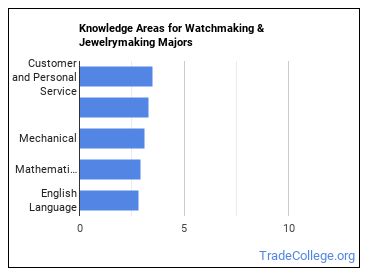
- Customer and Personal Service - Knowledge of principles and processes for providing customer and personal services. This includes customer needs assessment, meeting quality standards for services, and evaluation of customer satisfaction.
- Production and Processing - Knowledge of raw materials, production processes, quality control, costs, and other techniques for maximizing the effective manufacture and distribution of goods.
- Mechanical - Knowledge of machines and tools, including their designs, uses, repair, and maintenance.
- Mathematics - Knowledge of arithmetic, algebra, geometry, calculus, statistics, and their applications.
- English Language - Knowledge of the structure and content of the English language including the meaning and spelling of words, rules of composition, and grammar.
Skills for Watchmaking and Jewelrymaking Majors
A major in watchmaking and jewelrymaking prepares you for careers in which the following skill-sets are crucial:
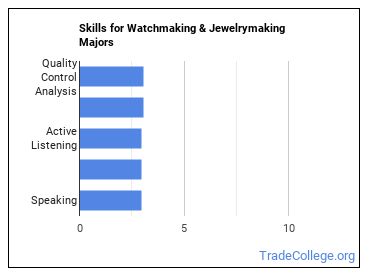
- Quality Control Analysis - Conducting tests and inspections of products, services, or processes to evaluate quality or performance.
- Critical Thinking - Using logic and reasoning to identify the strengths and weaknesses of alternative solutions, conclusions or approaches to problems.
- Active Listening - Giving full attention to what other people are saying, taking time to understand the points being made, asking questions as appropriate, and not interrupting at inappropriate times.
- Judgment and Decision Making - Considering the relative costs and benefits of potential actions to choose the most appropriate one.
- Speaking - Talking to others to convey information effectively.
Abilities for Watchmaking and Jewelrymaking Majors
As a watchmaking and jewelrymaking major, you will find yourself needing the following abilities:

- Finger Dexterity - The ability to make precisely coordinated movements of the fingers of one or both hands to grasp, manipulate, or assemble very small objects.
- Near Vision - The ability to see details at close range (within a few feet of the observer).
- Arm-Hand Steadiness - The ability to keep your hand and arm steady while moving your arm or while holding your arm and hand in one position.
- Control Precision - The ability to quickly and repeatedly adjust the controls of a machine or a vehicle to exact positions.
- Manual Dexterity - The ability to quickly move your hand, your hand together with your arm, or your two hands to grasp, manipulate, or assemble objects.
Who Is Getting an Associate’s Degree in Watchmaking and Jewelrymaking?
Racial-Ethnic Diversity
At the countrywide level, the racial-ethnic distribution of watchmaking and jewelrymaking majors is as follows:
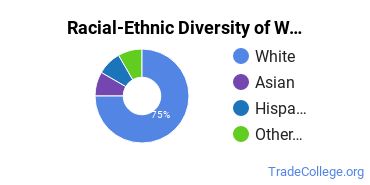
| Race/Ethnicity | Number of Grads |
|---|---|
| Asian | 0 |
| Black or African American | 0 |
| Hispanic or Latino | 2 |
| White | 6 |
| International Students | 0 |
| Other Races/Ethnicities | 0 |
How Much Do Watchmaking and Jewelrymaking Majors Make?
Salaries According to BLS
Watchmaking and Jewelrymaking majors often go into careers where salaries can range from $37,460 to $44,830 (25th to 75th percentile). This range includes all degree levels, so you may expect those with a more advanced degree to make more while those with less advanced degrees will typically make less.
To put that into context, according to BLS data from the first quarter of 2020, the typical high school graduate makes between $30,000 and $57,900 a year (25th through 75th percentile). The average person with a bachelor’s degree (any field) makes between $45,600 and $99,000. Advanced degree holders make the most with salaries between $55,600 and $125,400.
Amount of Education Required for Careers Related to Watchmaking and Jewelrymaking
Some careers associated with watchmaking and jewelrymaking require an advanced degree while some may not even require a bachelor’s. Whatever the case may be, pursuing more education usually means that more career options will be available to you.
Find out what the typical degree level is for watchmaking and jewelrymaking careers below.
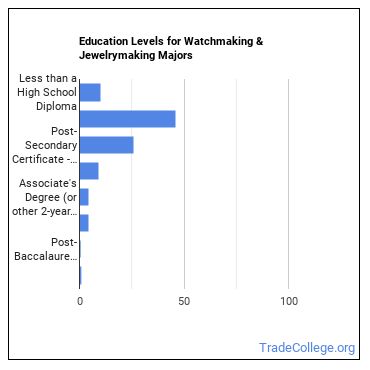
| Education Level | Percentage of Workers |
|---|---|
| Less than a High School Diploma | 10.2% |
| High School Diploma - or the equivalent (for example, GED) | 45.7% |
| Post-Secondary Certificate - awarded for training completed after high school (for example, in agriculture or natural resources, computer services, personal or culinary services, engineering technologies, healthcare, construction trades, mechanic and repair technologies, or precision production) | 25.6% |
| Some College Courses | 8.9% |
| Associate’s Degree (or other 2-year degree) | 4.5% |
| Bachelor’s Degree | 4.4% |
| Post-Baccalaureate Certificate - awarded for completion of an organized program of study; designed for people who have completed a Baccalaureate degree but do not meet the requirements of academic degrees carrying the title of Master. | 0.3% |
| First Professional Degree - awarded for completion of a program that: requires at least 2 years of college work before entrance into the program, includes a total of at least 6 academic years of work to complete, and provides all remaining academic requirements to begin practice in a profession. | 0.6% |
Online Watchmaking and Jewelrymaking Programs
The following table lists the number of programs by degree level, along with how many schools offered online courses in the field.
| Degree Level | Colleges Offering Programs | Colleges Offering Online Classes |
|---|---|---|
| Certificate (Less Than 1 Year) | 0 | 0 |
| Certificate (1-2 years) | 3 | 0 |
| Certificate (2-4 Years) | 2 | 0 |
| Associate’s Degree | 3 | 0 |
| Bachelor’s Degree | 0 | 0 |
| Post-Baccalaureate | 0 | 0 |
| Master’s Degree | 0 | 0 |
| Post-Master’s | 0 | 0 |
| Doctor’s Degree (Research) | 0 | 0 |
| Doctor’s Degree (Professional Practice) | 0 | 0 |
| Doctor’s Degree (Other) | 0 | 0 |
Is a Degree in Watchmaking and Jewelrymaking Worth It?
The median salary for a watchmaking and jewelrymaking grad is $43,570 per year. This is based on the weighted average of the most common careers associated with the major.
This is 9% more than the average salary for an individual holding a high school degree. This adds up to a gain of about $73,400 after 20 years!
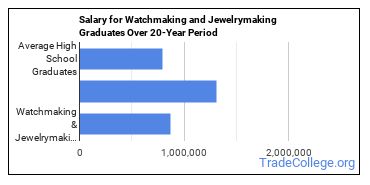
Explore Major by State
Alabama
California
District of Columbia
Idaho
Kansas
Maryland
Mississippi
Nevada
New York
Oklahoma
South Carolina
Utah
West Virginia
Alaska
Colorado
Florida
Illinois
Kentucky
Massachusetts
Missouri
New Hampshire
North Carolina
Oregon
South Dakota
Vermont
Wisconsin
Trades Related to Watchmaking and Jewelrymaking
You may also be interested in one of the following majors related to watchmaking and jewelrymaking.
| Major | Number of Grads |
|---|---|
| Gunsmithing/Gunsmith | 1,820 |
| Musical Instrument Fabrication & Repair | 194 |
| Locksmithing & Safe Repair | 72 |
| Precision Systems Maintenance & Repair Technologies, Other | 25 |
References
*The racial-ethnic minorities count is calculated by taking the total number of students and subtracting white students, international students, and students whose race/ethnicity was unknown. This number is then divided by the total number of students at the school to obtain the racial-ethnic minorities percentage.
- College Factual
- College Scorecard
- National Center for Education Statistics
- O*NET Online
- U.S. Bureau of Labor Statistics
- Usual Weekly Earnings of Wage and Salary Workers First Quarter 2020
- Image Credit: By Phasmatisnox under License
More about our data sources and methodologies.
